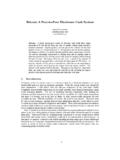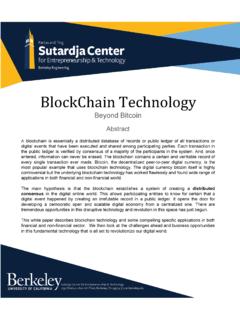Transcription of Conflict and Natural Resource Management
1 ConflictandNatural ResourceManagement The designations employed and the presentation of material in this publication do not imply the expression ofany opinion whatsoever on the part of the Food and Agriculture Organization of the United Nations concerningthe legal status of any country, territory, city or area or of its authorities, or concerning the delimitation of itsfrontiers or boundaries. The opinions expressed in this document are those of the authors and do not neces-sarily reflect the position of the Food and Agriculture Organization of the United rights reserved. No part of this publication may be reproduced, stored in a retrieval system or transmittedin any form or by any means, electronic, mechanical, photocopying or otherwise, without the prior permissionof the copyright owner.
2 Applications for such permission, with a statement of the purpose and extent of thereproduction, should be addressed to the Director, Information Division, Food and Agriculture Organization ofthe United Nations, Viale delle Terme di Caracalla, 00100, Rome, Italy. FAO 2000 TEXT BY Violet MatiruEDITED BY Nancy Hart and Peter CastroILLUSTRATIONS BY Guida Joseph and Aldo Di DomenicoDESIGN BY MaxtudioPHOTOGRAPHS BY Roberto FaiduttiNATURAL Resource CONFLICTSare disagreements and disputes over access to, andcontrol and use of, Natural resources. These conflicts often emerge because people have dif-ferent uses for resources such as forests, water, pastures and land, or want to manage themin different ways. Disagreements also arise when these interests and needs are incom-patible, or when the priorities of some user groups are not considered inpolicies, programmes and projects.
3 Such conflicts of interest are aninevitable feature of all societies. In recent years, the scope and magnitude of Natural Resource con-flicts have increased and intensified. These conflicts, if not addressed,can escalate into violence, cause environmental degradation, disrupt projects andundermine livelihoods. Acknowledging that Conflict is a common feature of any Resource usesystem is a prerequisite for sustainable Management that is participatory and Resource Conflict Management andResolutionWhat are Natural resourceconflictsand their consequences? Natural Resource CONFLICTS have always been with us,due in part to the multiple and competing demands onresources. Conflicts can arise if user groups are excluded fromparticipating in Natural Resource Management .
4 They also occur ifthere are: contradictions between local and introduced Management systems;misunderstandings and lack of information about policy and programme objectives; contra-dictions or lack of clarity in laws and policies; inequity in Resource distribution; or poor policyand programme implementation. Conflict will always exist to some degree in every community, but it can often be managedand FORESTRYTHE FORM AND INTENSITYof conflicts varywidely by place, and over time within any community. Conflicts manifest themselves inmany ways, ranging from breaking rules to acts ofsabotage and violence. Sometimes conflicts remain hidden or latent. People may allow grievances to smoulderbecause of fear, distrust, peer pressure, financial constraints, exclusion from certain conflictresolution procedures, or for strategic reasons.
5 Because some societies encourage their members to avoid public confrontations, a lack of public disputes does not mean there is noconflict. Why do conflicts arise?How do conflicts manifest themselves? Natural Resource CONFLICTS occur at various levelsand involve a variety of actors. They range from conflicts amonglocal men and women over the use of trees, to conflicts amongneighbouring communities disputing control over woodland, to vil-lages, community-based organizations, domestic and multinational businesses,governments, international development agencies and NGOs in Conflict over the use and man-agement of large forest tracts. Most conflicts are characterized by the presence of multiplestakeholders who themselves may have subgroups with varying and Natural Resource Management3 Scenario ICOMMUNICATING CONFLICTING INTERESTSTHROUGH ELECTRONIC MEDIA A government created a protected area because of its high biologi-cal diversity and historical significance.
6 National authorities collab-orated with several international conservation agencies to develop amanagement plan that proposed banning cultivation in the area,despite the presence of farming communities. The local people didnot find out about the plan until it was finalized. Residents voicedtheir objections but officials dismissed their grievances. With assistance from an international conservation group, vil-lagers, both literate and illiterate, made video recordings of theirobjections to the plan. The videos were distributed widely, includingon the World Wide Web. The use of electronic media elevated theconflict into the global arena. Who are thedifferent actors?THE WAYS IN WHICH PEOPLE(even those from thesame community) respond to Natural Resource conflicts varyconsiderably.
7 All communities have their own ways of handlingconflicts. These mechanisms may be formal or informal, violent orpeaceful, equitable or not. Although the specific strategies may vary, people generally rely on the same basic procedural modes to handle conflicts: avoidance, coercion,negotiation, mediation, arbitration and involved in Natural Resource conflicts take courses of action based on their prefer-ences, their understanding of their options, their perceived likelihood for success and theirrelationship with an opponent. Not all people have equal access to all options gender, class,age and other factors may restrict the options of certain groups and individuals. Seasonality,through its influence on labour patterns and income flow, can affect the ability of people to , the nature of the Conflict itself may prescribe the use of certain legal FORESTRYHow do different groupsdealwith Natural resourceconflicts?
8 Conflict and Natural Resource Management5 DefinitionsofKey Conflict ManagementandResolution StrategiesAvoidanceActing in ways to keep a Conflict from becoming publicly or using force to impose one s will. Following a voluntary process inwhich parties reach agreementthrough a third party to facilitate thenegotiation process. (A mediator lacksthe authority to impose a solution).ArbitrationSubmitting a Conflict to a mutually agreeable third party, who renders a on a judge or administrator to make a binding FORESTRYNATURAL Resource POLICIES, programmes and projects offer significant means ofaddressing many of the needs and concerns that propel Resource -related conflicts. Ironically,policies, programmes and projects themselves can serve as sources or arenas of Conflict , eventhough their intention is to ameliorate such conflicts.
9 This situation generally arises when thereis inadequate local participation in all phases of interventions, and when insufficient consider-ation is given to anticipating conflicts that might ResourceManagement Policies,Programmes andProjects asSources and Arenas ofConflictConflict and Natural Resource Management7 Natural Resource POLICIES andinterventions are often formulated withoutthe active and sustained participation ofcommunities and local Resource users. Forexample, some governments have long relied oncentralized Management strategies based on centralized control byadministrative units and technical experts. These policies and practices frequently fail to takeinto account local rights to, and practices regarding, Natural resources. For example, the intro-duction of new policies and interventions without local input may end up supplanting, under-mining or eroding community institutions governing Resource imposedwithout local participationSome reasons why conflicts may arise duringpolicy, programme and project implementation.
10 Policies imposed without local participation lack of harmony and coordination between bodies of law and legal procedures poor identification of and inadequate consultation with stakeholders uncoordinated planning inadequate or poor information sharing limited institutional capacity inadequate monitoring and evaluation of programmes lack of effective mechanisms for Conflict managementMOST COUNTRIES ARE CHARACTERIZEDby legal pluralism the operation of different bodies of formal and informal lawsand legal procedures within the same socio-political legal orders may be rooted in the nation-state, reli-gion, ethnic group, local custom, international agreements orother entities. They often overlapresulting in different legal bodies that can becomplementary, competitive or conflicts sometimes emerge becausethere is a lack of harmony and coordination amongthese different legal orders, particularly when poli-cies, programmes and projects fail to considerlocal FORESTRYL ackofharmonyandcoordination betweenbodiesoflawandlegalproceduresScen ario IILACK OF COORDINATION BETWEEN THE FORMAL LEGALSYSTEM AND CUSTOMARY LAWAn international development agency provided support to rehabilitate andimprove a traditional hand-dug well, controlled by a single local clan.













![日本語で読むビットコイン原論文 [by Satoshi Nakamoto]](/cache/preview/1/9/5/5/b/c/2/5/thumb-1955bc25ea3872474f97c28fc2386e72.jpg)
